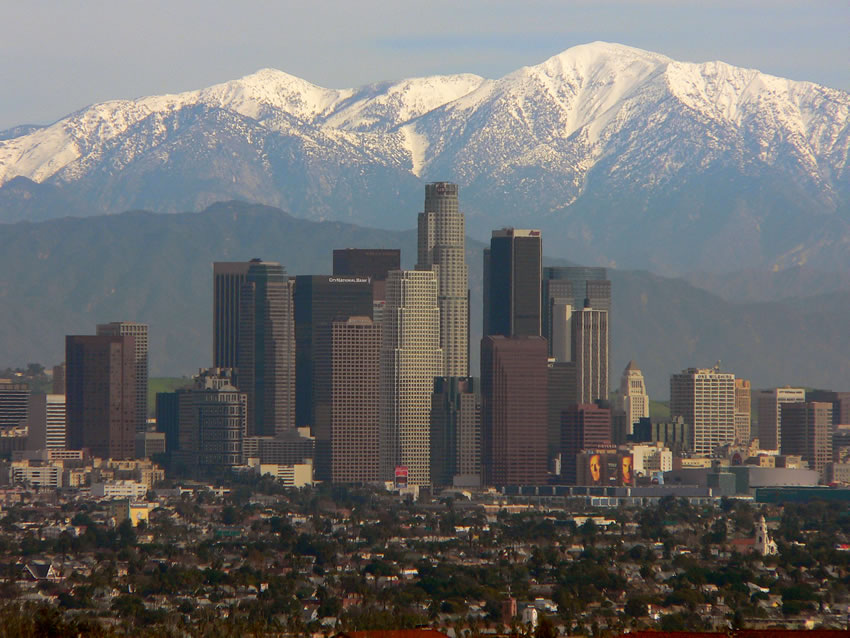Urban National Forests

The skyline of Los Angeles with the San Gabriel Mountains in the background. Photo Forest Service.
From 1990 to 2010, the population living within 50 miles of National Forest System lands increased by 36 percent, from about 112 million to 153 million people, and that population is continuing to increase. Almost 60 National Forests and Grasslands are surrounded by populations of 1 million or more people, and can be considered urban national forests. Learn more about urban national forests in the Paths More Traveled: Predicting Future Recreation Pressures on America’s National Forests and Grasslands.
While urban national forests face many of the same issues and pressures as our other public lands, they also have some unique opportunities and challenges. Large populations nearby can mean many visitors, making urban national forests a wonderful opportunity for the American people to connect with their public lands. However, urban national forests must consider issues related to resource damage, stress on recreation infrastructure, urban sprawl and forest fragmentation, utility corridors, preserving water supply and quality, and engaging a public that has diverse values, behaviors and experiences.
There are many tools available to help people explore and partner with their urban national forests, as well as to help staff on urban national forests connect with and serve the public:
- Why should you care about your National Forests? It’s all yours. They may supply your drinking water.
- Wondering what you can do on a National Forest or how to prepare for your trip? Discover the Forest helps reconnect your family with nature by exploring the forest or park near you.
- Ready to plan your next adventure? Recreation.gov is your one-stop resource for trip planning, information and advanced reservations across federal lands and sites. Recreation.gov enables you to book campsites, picnic shelters, historic tours, cave tours, guided hikes, whitewater rafting permits, wilderness canoe trips, climbing adventures and more!
Resources for Urban National Forests
- Connect with your Regional Urban & Community Forestry (UCF) Program Manager. The UCF program is delivered through a broad network of partners, including states, and UCF staff can help you:
- Leverage Forest Service and partner data and tools, including State Forest Action Plans, that look across all forest ownerships to aid in forest planning, environmental analysis and community engagement
- Pull together stakeholders, including other landowners, to conduct landscape scale planning
- Advise interdisciplinary teams performing environmental analysis on engaging with urban communities and considering urban natural resources
- Inform, connect with and activate key partners and urban natural resource stewards working in communities near your national forest.
- Forest Service Research & Development provides leading science and new technology that informs stewardship and improves environmental health and community well-being in urban areas. Our research helps to create more livable, desirable, sustainable communities.
- The Forest Service Urban Field Station Network works to improve the quality of life in urban and urbanizing areas by conducting and supporting short-term and long-term research and science delivery about urban social-ecological systems and urban resource management.
- Learn about how Forest Service staff can engage in local planning in Across the Green Line: How Forest Service Employees Can Support Local Land Use Planning Efforts
- Inform stakeholders and adjacent land owners about the value of forests. The Vibrant Cities Lab, developed by the U.S. Forest Service in partnership with American Forests and the National Association of Regional Councils, provides local decision makers with the best available science to inform why they should care about and invest in trees and forests, and gives them the tools they need to build our robust forestry programs. It can help urban national forests make the case for partnering to protect our public lands and urban natural resources.
- In 19 cities across the country the Urban Waters Federal Partnership engages urban populations in restoring their rivers and surrounding neighborhoods, improving access for water recreation, promoting economic revitalization and prosperity through urban water systems, and helping create a network of parks and green spaces connecting downtown cores with suburban and rural areas and National Forests through community-led revitalization efforts.
